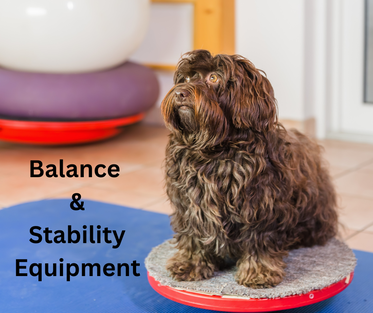|
The bond between dogs and humans is growing stronger and more significant, leading to increased dedication by dog owners to provide the best possible care for their pets. Canine rehabilitation is becoming increasingly popular with dog owners as it provides a source of hope and healing for dogs dealing with various health conditions. In this blog post, we will examine some of the most commonly used tools in canine rehabilitation that I recommend. 1. Underwater Treadmills Underwater treadmills are one of the most effective tools in canine rehabilitation and are one of the reasons I chose to move away from a mobile business to a brick-and-mortar business. This technology allows dogs to exercise without bearing their full weight, reducing strain on their joints and muscles. The underwater treadmill therapy improves muscle strength and joint flexibility in dogs recovering from orthopaedic injuries and surgeries. I also love it as it is a functional movement and the buoyancy of water provides low-impact resistance, making it easier for canines to regain strength and mobility and is a firm favourite in my practice. 2. Therapeutic Ultrasound Therapeutic ultrasound is another modality that can be found in canine rehabilitation practice. This non-invasive treatment utilises high-frequency sound waves to promote tissue healing and helps with inflammation. I particularly use it on conditions such as ligament and tendon injuries or pathologies. 3. Balance and Stability Equipment Balance and stability equipment plays a vital role in enhancing a dog's core strength and proprioception. When it comes to balance equipment, there is a plethora to choose from! My go-to's are the inclined wedge, peanut stability ball and a dura disc. Stability balls and balance boards are great as they help dogs improve their balance and coordination, especially after neurological injuries. These tools challenge the dog's body to maintain stability, thereby strengthening muscles and improving overall stability. 4. Laser Therapy
Laser therapy, also known as photobiomodulation or LLLT has gained popularity in canine rehabilitation due to its ability to alleviate pain and promote tissue repair. Laser therapy has also been shown to reduce pain and improve joint mobility in dogs with arthritis. The application of low-level laser light stimulates cellular activity, leading to accelerated healing and reduced inflammation. Out of any modality in my clinic, the laser is my most favourite. It is non-invasive and non-painful to administer. It also doesn't require a gel (unlike the ultrasound machine) to use it. 5. Therapeutic Massage Therapeutic massage has long been recognised as a beneficial treatment for both humans and animals. Massage therapy can reduce muscle tension and improve the flexibility of tissues, particularly with dogs that have musculoskeletal conditions. Skilled massage techniques help increase circulation, reduce scar tissue, and enhance the release of endorphins, all of which contribute to the dog's overall well-being. 6. Assisted Rehabilitation Devices Assisted rehabilitation devices, such as harnesses and slings, are instrumental in supporting dogs during the recovery process. There are several ones to choose from however the one I reach for the most would have to be the help 'em up harness. This harness is adjustable in all aspects, has a front and rear fit (which can be detached if needed) and has strong steady handles to help assist any dog in need of a helping hand. I find that in practice, dogs that need the help em up harnesses regain their confidence and function faster than those that don't. The proper use of harnesses and slings assists dogs in walking and exercising, preventing further injury while building strength. The field of canine rehabilitation has made great strides in improving the quality of life for dogs. The most effective tools that I use in practice include underwater treadmills, therapeutic ultrasound, balance and stability equipment, laser therapy, therapeutic massage, and assisted rehabilitation devices. By utilising the latest tools and techniques in canine rehabilitation, rehab therapists can help dogs lead a healthier and happier life. Staying informed about the latest research and advancements in this field is essential to providing the best care possible for our dogs, enriching their lives and ours |
AuthorJoanna Whitehead Archives
June 2024
Categories
All
|


 RSS Feed
RSS Feed
